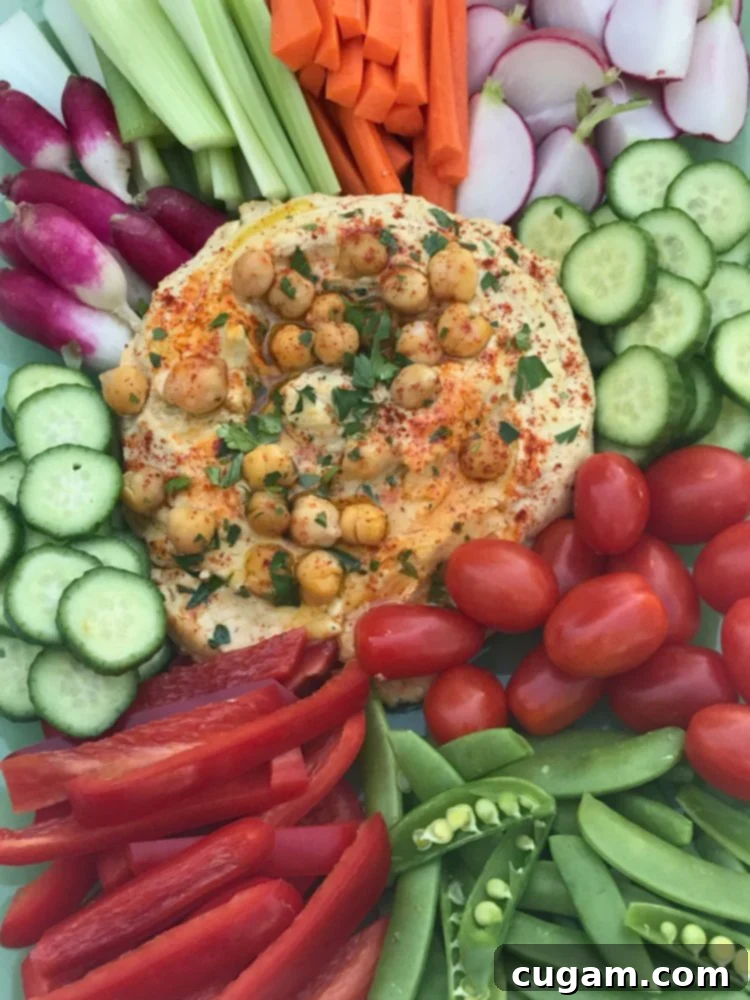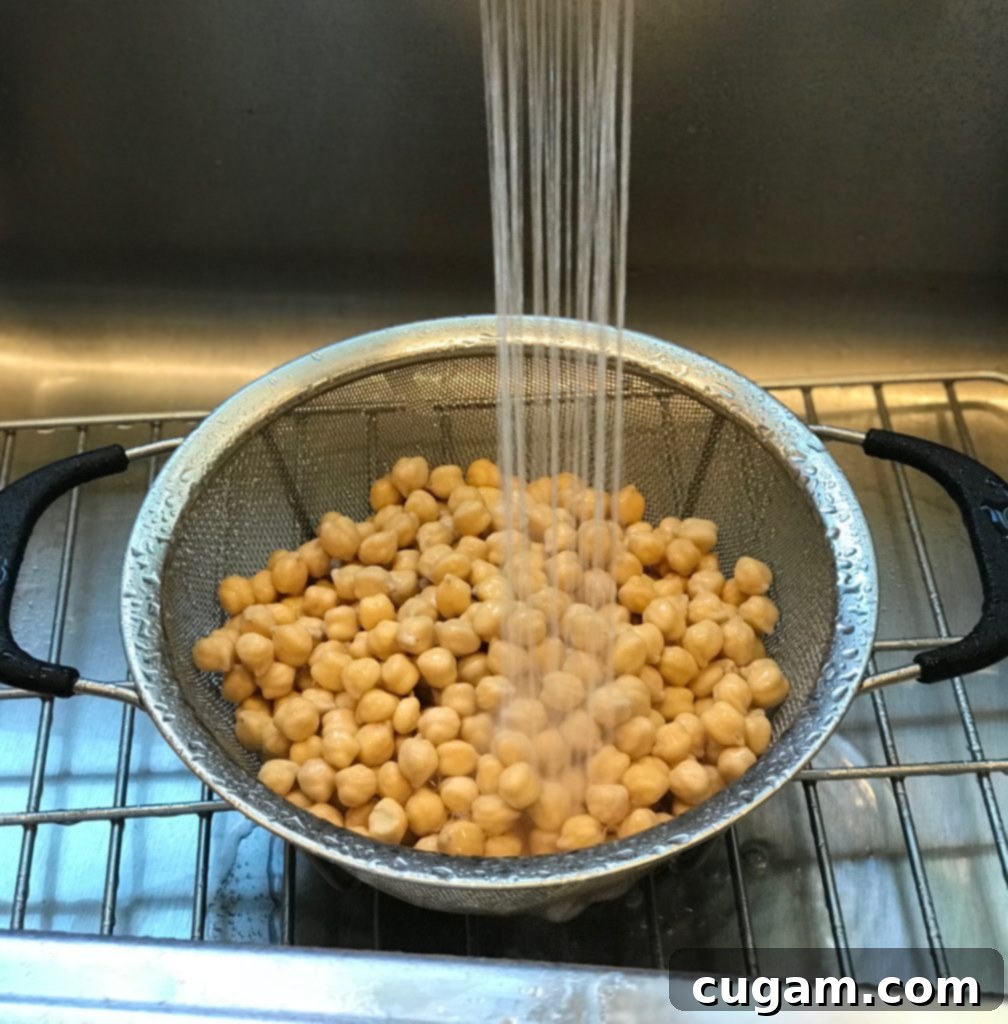Creamy Oil-Free Hummus: The Ultimate Guide to a Healthy, Homemade Dip
Prepare to fall in love with homemade hummus that’s not only incredibly rich and creamy but also completely oil-free and bursting with nutrition. This recipe transforms simple dried chickpeas into a velvety, satisfying dip that’s truly a game-changer. Whether you’re seeking a wholesome appetizer, a quick and healthy snack, or a versatile spread for your favorite sandwiches and wraps, our oil-free hummus delivers on all fronts: amazing flavor, stellar health benefits, and surprising ease of preparation. Say goodbye to store-bought varieties and embrace the fresh, clean taste of homemade!
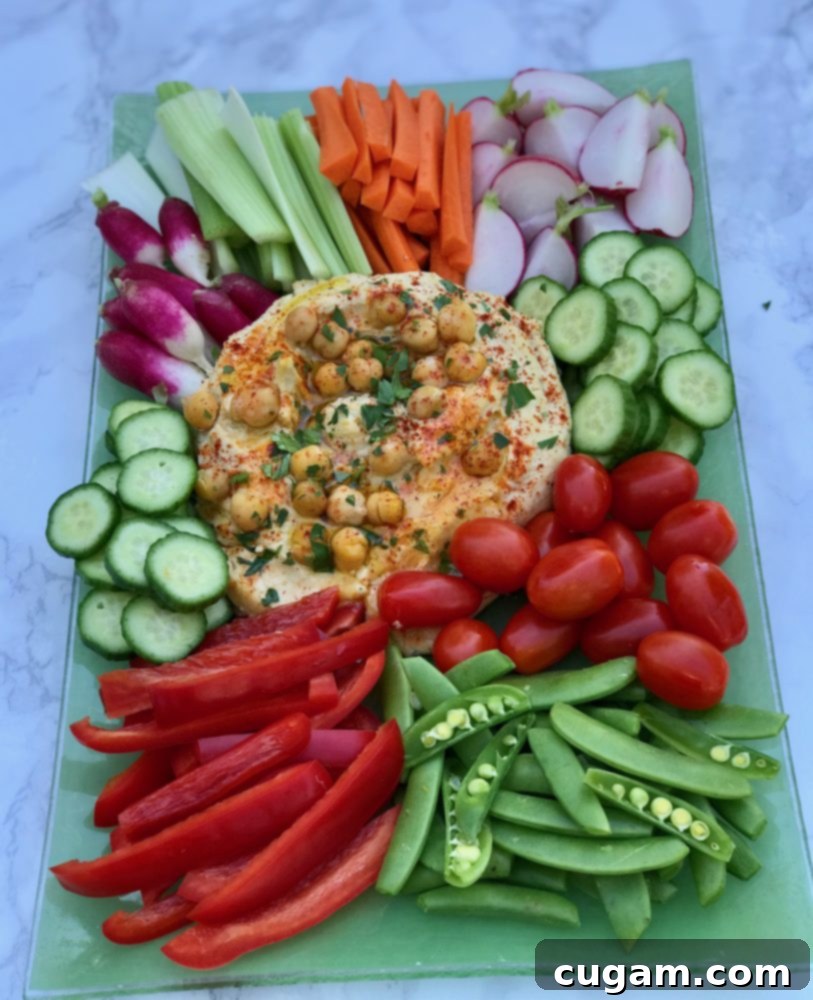
This post has been lovingly updated from its original publication on May 22, 2018, bringing you enhanced tips and fresh insights for crafting the perfect homemade hummus.
Life’s milestones often bring moments of joyful indulgence, and we recently experienced just that. Our home was overflowing with pride and happiness as my youngest daughter celebrated her college graduation. With both my mom and dad present, the occasion felt even more profound and special. Naturally, such celebrations are often marked by an abundance of delicious food, and I certainly enjoyed my share! However, after a wonderful weekend of feasting, I’m always eager to return to my foundational principles of a whole-foods, unprocessed diet. My first choice for a nutritious reset? A generous batch of my beloved oil-free hummus.
This creamy, flavorful dip is more than just a tasty treat; it’s an effortless and enjoyable way to boost your intake of vegetables and vital plant-based protein. It’s an absolute lifesaver for meal prep, as it stays beautifully fresh and delicious in the refrigerator for up to two weeks. This means you’ll always have a healthy, versatile option on hand to elevate any meal or curb those midday cravings, making healthy eating both convenient and incredibly enjoyable.
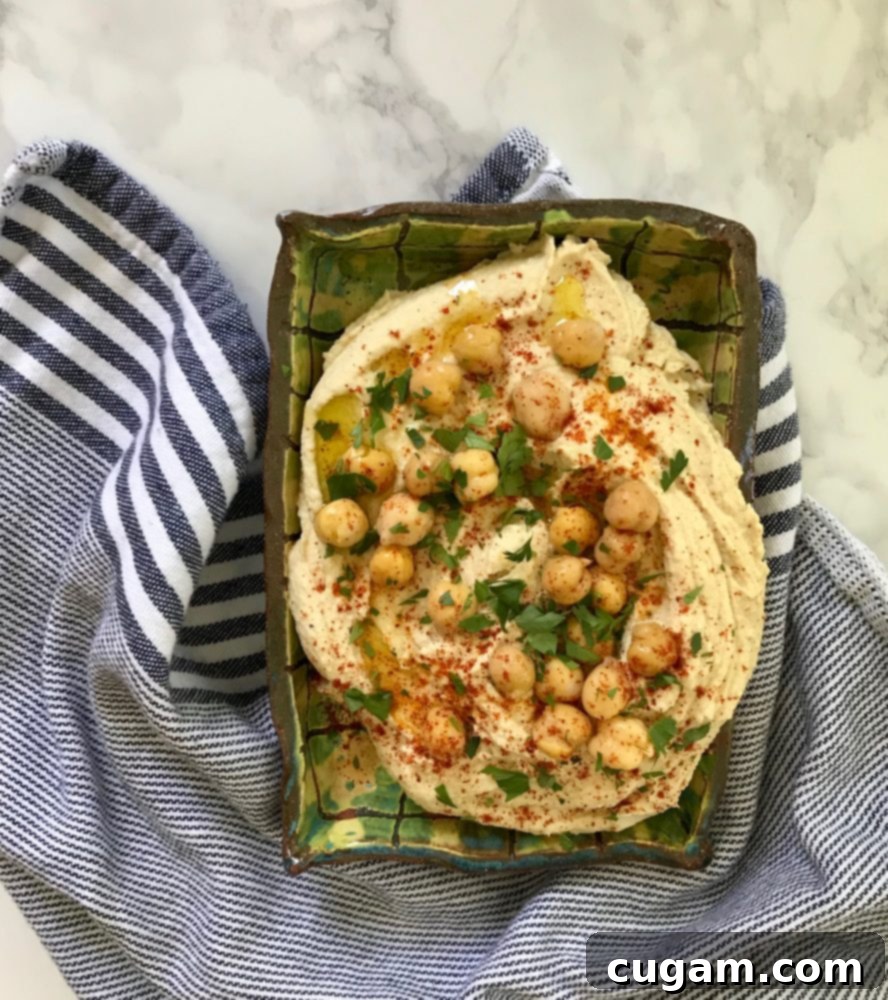
The Advantages of Homemade Oil-Free Hummus Over Store-Bought
While hummus generally holds a reputation as a healthy dip, a closer look at many commercially produced versions reveals a different story. They are frequently loaded with refined oils (like canola or soybean oil), artificial preservatives, and an excessive amount of sodium. These additions can undermine the natural health benefits of chickpeas and tahini, turning a seemingly wholesome choice into a less-than-ideal option for a balanced diet. Crafting your own hummus at home is not just an act of culinary empowerment; it’s a commitment to cleaner eating and superior flavor.
Our unique oil-free hummus recipe achieves its extraordinary creaminess without a single drop of added oil. The secret lies in the synergistic combination of high-quality tahini (sesame paste), freshly squeezed lemon juice, and the magic of ice-cold water. This trio works together to create a smooth, light, and perfectly emulsified texture that rivals any traditional recipe. By making it yourself, you gain complete control over every ingredient, allowing you to select the purest components and adjust seasonings to your exact preference. This ensures a truly clean, genuinely healthy, and incredibly flavorful dip free from unwanted additives and unhealthy fats.
Achieving the Perfect Texture: Dried vs. Canned Chickpeas for Hummus
For an unparalleled hummus experience, I genuinely believe that starting with dried chickpeas is the way to go. The depth of flavor, superior texture, and natural creaminess achieved from scratch are simply unmatched by canned varieties. Beyond taste, soaking and cooking dried beans significantly improves their digestibility, helping to minimize the bloating that some people experience with legumes. While the process of soaking and cooking dried beans might appear daunting, I promise it’s quite straightforward and profoundly rewarding. The exquisite taste and silken texture you’ll achieve are absolutely worth the minimal extra effort, and it’s a remarkably cost-effective method in the long run.
Nevertheless, I understand that modern life doesn’t always allow for extensive kitchen time. If soaking and cooking dried chickpeas doesn’t fit into your busy schedule, please don’t let that deter you from enjoying homemade hummus. Opting for good quality canned (or boxed) chickpeas is a perfectly acceptable and still significantly healthier alternative to purchasing heavily processed store-bought options. When selecting canned chickpeas, be sure to choose brands that contain no undesirable additives and ideally have lower sodium content. A thorough rinse and drain of canned chickpeas will still yield a wonderfully tasty, clean, and smooth hummus that far outshines most conventional supermarket offerings. My philosophy remains: homemade is always best, even if you need to take a convenient shortcut on the beans!
Unlocking the Nutritional Power of Hummus: Key Health Benefits
Beyond its irresistible taste and remarkable versatility, hummus – primarily powered by its star ingredient, chickpeas – is a true nutritional powerhouse. Integrating this fantastic plant-based dip into your regular diet can offer a profound array of health advantages:
- Chickpeas increase satiety and help with weight loss. Chickpeas are an exceptional source of both dietary fiber and plant-based protein, two crucial macronutrients renowned for their ability to promote feelings of fullness and sustain energy levels. This prolonged satiety naturally reduces the likelihood of reaching for unhealthy, empty-calorie processed snacks, making hummus an invaluable tool in effective weight management and the cultivation of healthier eating patterns.
- Chickpeas provide essential vitamins and minerals. These modest legumes are abundantly packed with a diverse range of vital micronutrients. They offer substantial quantities of iron, zinc, folate, phosphorus, and various B vitamins, each playing indispensable roles in sustaining overall bodily functions, optimizing energy production, and supporting cognitive health. This makes chickpeas particularly vital for individuals adhering to vegetarian or vegan diets, providing reliable plant-based sources for these critical nutrients.
- Chickpeas are a great source of plant-based protein. For anyone embracing a vegetarian or vegan lifestyle, or simply aiming to decrease their meat consumption, chickpeas represent a superb and readily available source of high-quality plant protein. Protein is fundamental for muscle repair, growth, and the smooth operation of countless physiological processes. Consistently incorporating protein-rich legumes like chickpeas into your meals ensures you meet your adequate daily protein requirements.
- Chickpeas provide slow-releasing carbohydrates and help control blood sugar levels: In stark contrast to refined carbohydrates that typically trigger rapid and undesirable spikes in blood sugar, the complex carbohydrates and significant fiber content in chickpeas are digested at a much slower pace. This gradual release of glucose into the bloodstream is instrumental in stabilizing blood sugar levels, effectively preventing the sudden energy crashes often associated with less wholesome food choices. This makes them an exemplary “good carb” for achieving sustained energy and mental clarity throughout your day.
- Chickpeas are high in fiber and improve digestion. Dietary fiber is absolutely essential for maintaining a robust and healthy digestive system. Chickpeas are particularly rich in both soluble and insoluble fiber, which collaboratively ensure the efficient and smooth transit of food through the digestive tract. This can lead to a considerable reduction in symptoms associated with irritable bowel syndrome (IBS) and chronic constipation, actively promoting regularity and fostering superior gut health.
- Chickpeas help protect against heart disease and cancer: Consistent consumption of chickpeas has been associated with a number of profound cardiovascular benefits. Scientific studies indicate their capacity to help regulate unhealthy cholesterol levels by actively lowering LDL (the “bad”) cholesterol, mitigating hypertension, and hindering the accumulation of plaque within arterial walls. Furthermore, their potent combination of antioxidants and rich fiber content contributes significantly to their protective properties against the development of certain types of cancer.
- Chickpeas have an alkalizing effect: When chickpeas are thoughtfully combined with a healthy fat, such as the tahini in hummus, the absorption of their fat-soluble nutrients is notably enhanced. Legumes, including chickpeas, are widely recognized for their alkalizing influence on the body’s internal environment. In a contemporary dietary landscape often leaning towards acidity, integrating alkaline-forming foods is crucial for balancing the body’s pH levels, which is fundamentally important for optimal cellular function and overall holistic well-being.
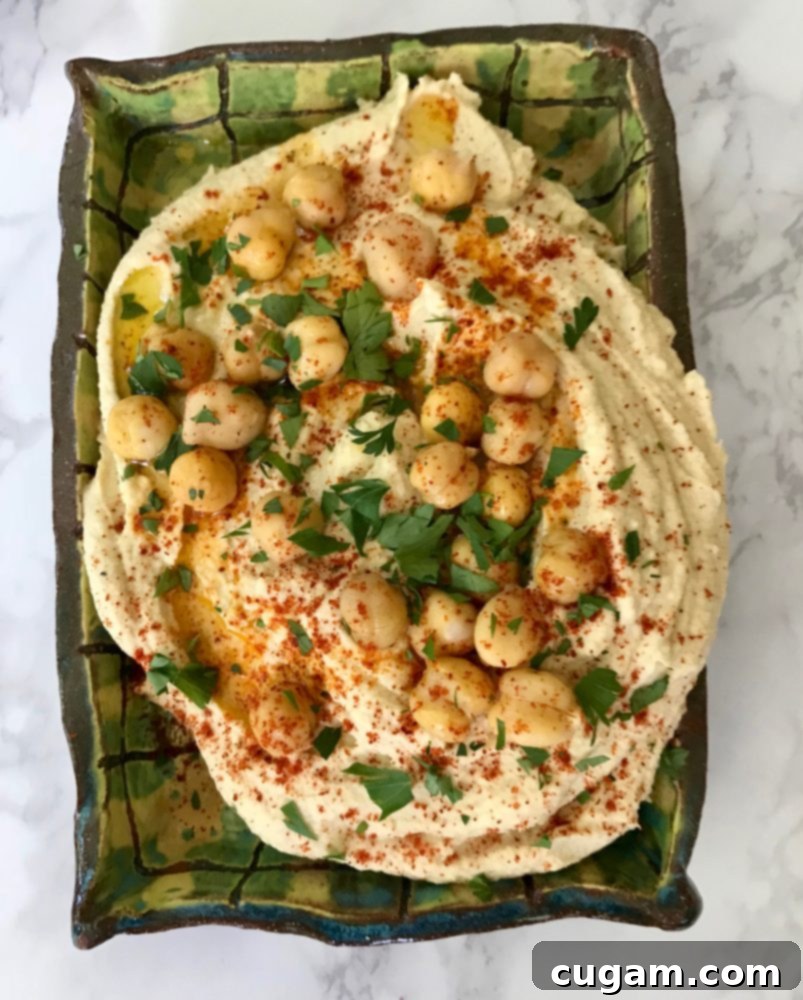
Expert Tips for the Silkiest, Smoothest Oil-Free Hummus
Achieving that highly sought-after, ultra-smooth, and creamy texture in your homemade hummus is not as difficult as it might seem. With a few professional tricks, you can elevate your hummus from good to absolutely glorious:
- Peel the Chickpeas for Ultimate Smoothness: This step is often considered the “secret weapon” for truly restaurant-quality hummus, making an astonishing difference in texture. Removing the thin, translucent skins from your cooked chickpeas is paramount for achieving that silky, velvety consistency. After cooking and rinsing, you can easily do this by gently rubbing the chickpeas between your palms or with a clean kitchen towel. The baking soda used during the cooking process also aids in loosening these skins, making them much easier to remove. Discarding these skins ensures no grainy bits interrupt your creamy delight.
- Invest in Quality Tahini: Tahini, a paste made from ground sesame seeds, is the soul of hummus. Its quality significantly impacts the final flavor and creaminess. Opt for a high-quality, runny tahini that flows easily and has a mild, nutty flavor rather than a bitter one. Always stir the tahini well in its jar before measuring to ensure all the oil is incorporated.
- The Magic of Ice-Cold Water: This is another crucial technique for achieving a lighter, fluffier texture. Adding ice-cold water gradually, a little at a time, while your food processor is running, helps to perfectly emulsify the tahini and chickpeas. This process aerates the mixture, resulting in a remarkably smooth and airy hummus that simply melts in your mouth. Don’t underestimate this simple but powerful tip!
- Process for Longer — Patience is Key: Don’t be shy with your food processor! Many home cooks stop processing too soon. For the creamiest results, allow your food processor to run for several minutes, often 3-5 minutes or even longer, scraping down the sides of the bowl periodically. The extended processing time breaks down the chickpeas more thoroughly, transforming the mixture into an incredibly smooth, almost ethereal consistency.
- Adjust to Taste and Consistency: Always taste your hummus as you go. You can add more lemon juice for a brighter flavor, a pinch more salt to enhance the overall taste, or a bit more ice water to achieve your desired consistency. Remember, more tahini will yield a richer, creamier hummus, while more water will make it thinner and lighter.
Versatile Ways to Enjoy Your Healthy Homemade Hummus
One of the most delightful aspects of homemade hummus is its incredible versatility. It’s far more than just a dip! Here are numerous creative ideas to incorporate this healthy, flavorful spread into your daily meals:
- The Quintessential Dip: Serve your luscious hummus with warm, fluffy pita bread or pita chips, a vibrant assortment of fresh vegetable sticks (carrots, celery, cucumber, bell peppers, radishes), or your favorite crunchy whole-grain crackers. It’s an instant hit and an elegant crowd-pleaser for any gathering or casual snack time.
- Revolutionary Sandwich & Wrap Spread: Bid farewell to unhealthy mayonnaise! Utilize hummus as a creamy, nutritious, and incredibly flavorful spread for all your sandwiches, wraps, and even veggie burgers. It adds essential moisture, a significant protein boost, and a delicious Mediterranean tang that elevates any handheld meal.
- Dynamic Salad Topping or Dressing Base: Dollop a generous spoonful of hummus onto your favorite green salad or grain bowl for an extra layer of protein and a delightful creaminess. For a lighter, pourable dressing, simply thin out your hummus with a little extra lemon juice or cold water, then drizzle over your greens.
- Power-Packed Grain Bowls: Build a wholesome and satisfying grain bowl by combining a base of cooked grains (like quinoa, farro, or brown rice) with roasted vegetables, a healthy protein source (like grilled tofu or tempeh), and a generous swirl of your homemade hummus.
- Savory Breakfast Innovation: Start your day with a nutritious twist! Spread hummus on toasted whole-grain bread or a bagel, then top with slices of fresh avocado, a sprinkle of everything bagel seasoning, chili flakes, or a scattering of fresh herbs for a unique and savory breakfast option.
- Elegant Finger Food: For an impressive yet simple appetizer, artfully stuff your homemade hummus into mini bell peppers, crisp endive leaves, or hollowed-out cucumber slices. Garnish with a sprinkle of paprika or fresh parsley for a touch of color.
- Pasta Sauce Thickener: Stir a spoonful of hummus into your pasta sauces for added creaminess and a boost of plant-based protein without needing heavy cream.
- Baked Potato Topping: Ditch the sour cream and butter! Top a warm baked potato or sweet potato with a dollop of hummus and your favorite veggies for a lighter, more nutritious meal.
As I continue to cherish the recent graduation memories, I’m also excitedly looking forward to the upcoming long Memorial Day Weekend. A generous batch of this healthy oil-free hummus will undoubtedly be making an appearance, joining a delicious array of other wholesome goodies perfect for beach days, backyard BBQs, and relaxing moments spent with cherished friends and family. It’s the kind of food that nourishes both body and soul, allowing for guilt-free enjoyment during festive times, creating new memories around healthy, delicious food.
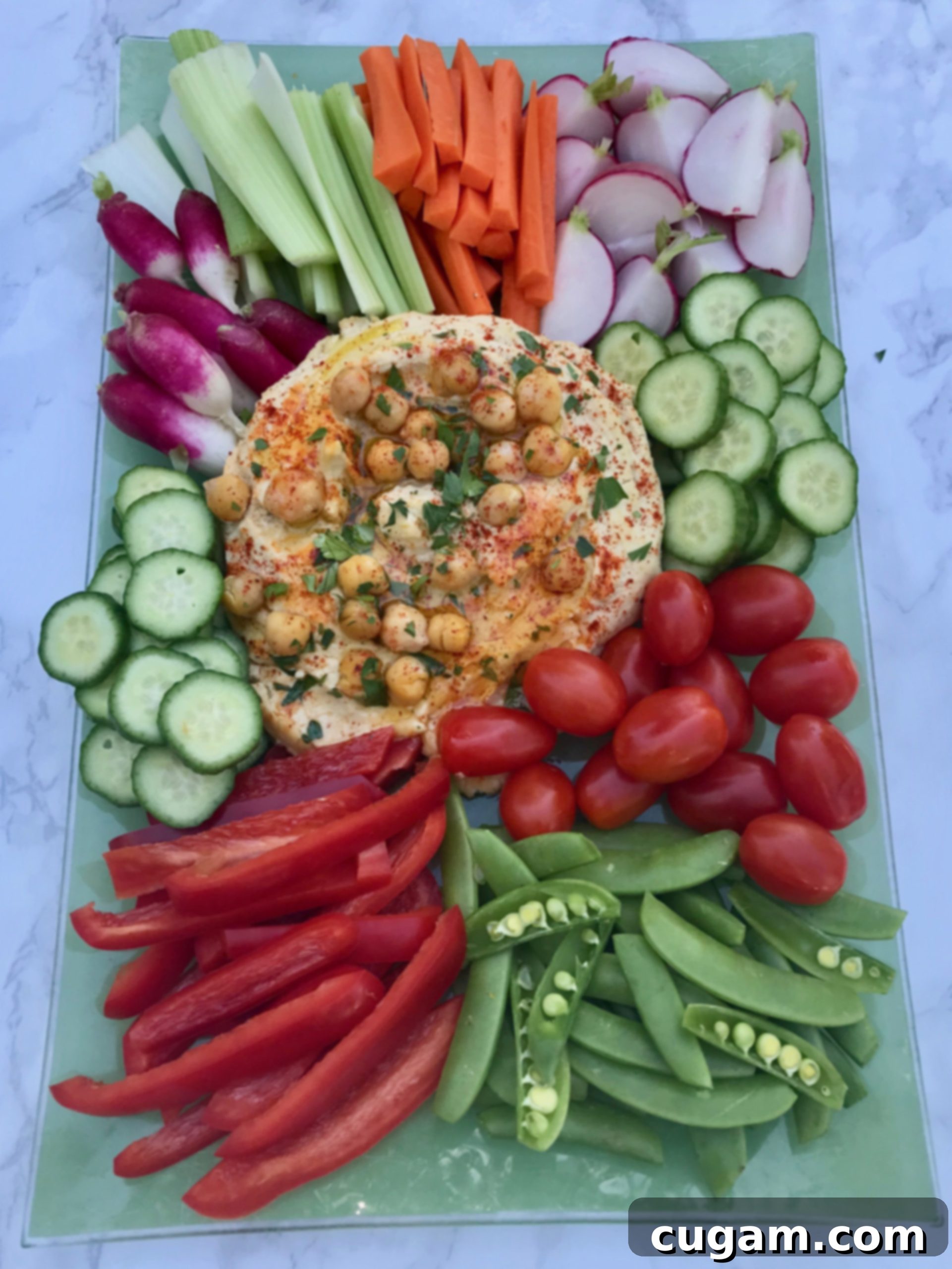
Throughout the Memorial Day Weekend, my culinary plans also include whipping up some other personal favorites like this light and satisfying Grilled Potato Salad, flavorful Mediterranean Grilled Veggie Kabobs bursting with fresh produce, or tender Grilled Asparagus with a Zesty Mustard Drizzle. For lighter, packable options perfect for beach outings, I’ll definitely be preparing a batch of my popular Vegan “Faux Chicken” Salad or perhaps some delicious Mock “Tuna” Salad. And, of course, no festive gathering is ever truly complete without a batch (or two!) of my incredible homemade Guacamole – a friendly reminder to stock up on fresh avocados mid-week for peak ripeness! A vibrant and tangy Tomatillo Salsa will also grace the menu, alongside some hearty veggie burgers and a refreshing Israeli Corn & Pickle Salad. I’m even contemplating making some delicate Veggie Spring Rolls with Peanut Sauce to contribute to a friend’s BBQ, beautifully paired with a decadent Chocolate Chunk Skillet Cookie and some fun, fruity watermelon skewers for a delightful dessert spread. Another wonderful weekend centered around fantastic, wholesome food? Absolutely! But rest assured, it’s all good, nourishing stuff that everyone, regardless of dietary preference, can enjoy wholeheartedly!
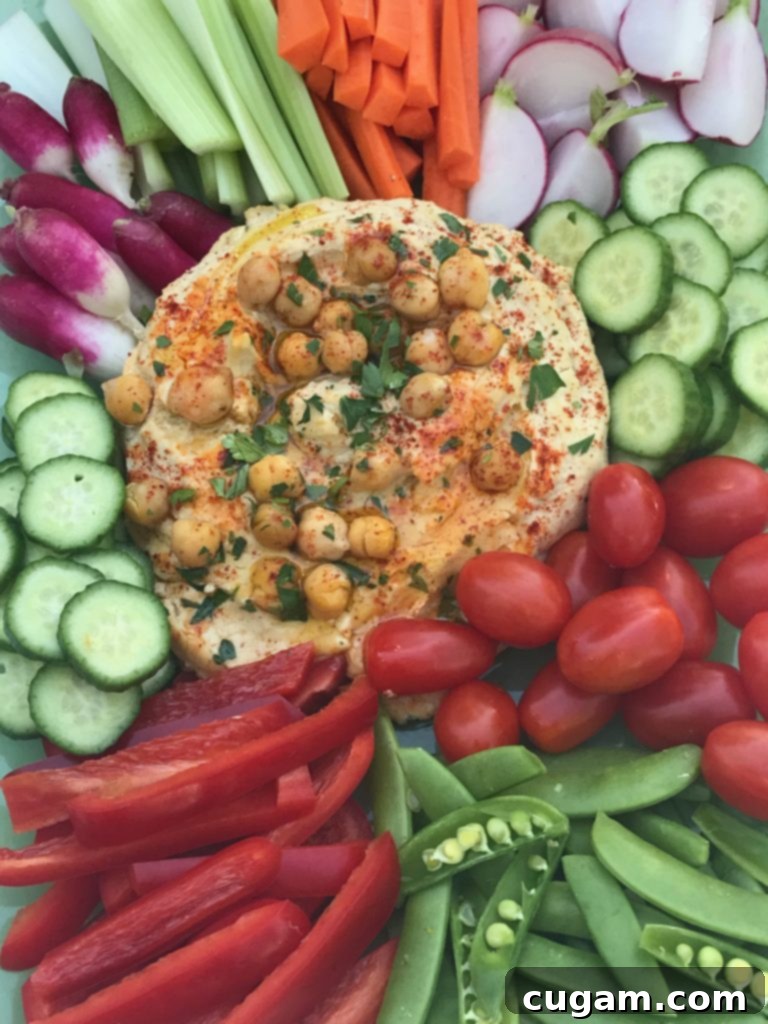
Did you know commenting and rating recipes is one of the best ways to support your favorite food bloggers? If you made this recipe, please consider leaving a five-star rating below and a friendly comment sharing your experience. Also, we’d absolutely love to see your creations! Please share your photos on Instagram by tagging me @dkhealthcoach and using the hashtag #debraklein so I can celebrate your delicious results!
📖 Recipe
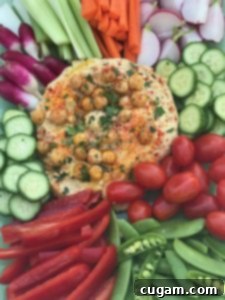
Oil-free Hummus
Rate this Recipe
Pin Recipe
Equipment
-
Food Processor
-
Instant pot
Ingredients
- 1 cup dried chick peas
- 1 teaspoon baking soda
- 4 cloves garlic
- ½ cup tahini
- 2 lemons juiced
- 1 ½ teaspoons sea salt
- 1 teaspoon cumin
- ⅓ cup ice cold water
Instructions
-
Place dried chick peas in a glass bowl and cover with water. Chick peas will double in size, make sure there is enough water covering so they will still be submerged as they soak. Soak overnight, or a minimum of 8 hours. Drain. Rinse. Drain again.
-
Place drained chick peas in a medium sauce pan. Sprinkle with baking soda, add the garlic cloves and then add enough water to cover chickpeas by 2-3”. Bring to a boil, reduce heat and simmer for 60-75 minutes, skimming off skins and any foam that float to the top. Chickpeas should be tender enough to squish when held between thumb and forefinger, but not mushy.
Or, use your INSTANT-POT….directions in the notes below.
-
Drain and rinse the cooked chickpeas until there are no bubbles. You should have about 3 cups (approximately 2 cans). Add the cooked garlic to the bowl of food processor. Peel the skins off chickpeas. This should be easy to do by rubbing with a clean kitchen towel. Discard skins and add the peeled chickpeas to the food processor, reserving ¼ cup of cooked chickpeas for use when serving. Add the tahini, lemon juice, salt and cumin. Process until smooth. Leave the food processor running and add half of the water. Continue to process adding remaining water 1 Tablespoon at a time. You may not need it all. Add in additional tahini or water depending on the consistency you want to achieve. More tahini=creamier, more water=thinner. Taste for seasoning, adding additional salt or lemon juice.
-
Serve at room temperature. Sprinkle on the chick peas that were set aside and some paprika or za’atar.
Notes
INSTANT POT: You can go from dried chickpeas to cooked chickpeas with no soaking in no time if you have an instant pot. Follow the basic directions above, but use the instant pot. Make sure it’s sealed. High pressure. 25 minutes for soaked beans or 40 minutes for dry beans without soaking. Allow instant pot to naturally release and then continue with directions above.
OPTIONAL TOPPINGS: swirl of olive oil, sprinkle of paprika or za’atar, chopped fresh herbs, additional whole chick peas, a swirl of sriracha or chopped jalapenos.
Nutrition
Note
The nutrition calculations were done using online tools. To obtain the most accurate representation of the nutritional information in any given recipe, you should calculate the nutritional information with the actual ingredients you used. You are ultimately responsible for ensuring that any nutritional information is accurate, complete and useful.
